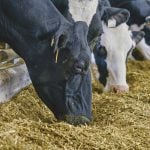A sharp drop in wholesale beef prices, along with softer fed cattle values, caused the feeder market to finally run into some resistance last week. Adverse weather also tempered buying enthusiasm for lighter-weight cattle, with dreadful temperatures reported across most of Western Canada.
The feeder market is indeed functioning to encourage production and ration demand, but this doesn’t appear to be occurring at the grassroots level. Good-quality bred cows were selling for $1,000 to $1,200 at many auction barns, and with 500- to 600-pound steers readily selling for $190 to $210 per hundredweight (cwt), these mothers feel the market is leaving them behind.
Read Also

U.S. livestock: Cattle regain ground, hogs dip
Chicago cattle futures regained ground on Wednesday after falling off a cliff late last week. Most-active December live cattle contracts…
Larger-frame medium-flesh exotic steers weighing just under 850 lbs. sold for $168/cwt, landed in southern Alberta feedlot. Charolais-cross steers weighing a breeze over 700 lbs. sold for $175/cwt, landed in the Calgary area. A mixed group of Angus-based bawlers weighing around 550 lbs. with no special features were quoted at $210/cwt landed in the Lethbridge area. Alberta packers were buying fed cattle in the range of $139-$140/cwt, down from the highs of $148.50/cwt seven days earlier.
Doing some rough calculations, the break-even price on current 850-lb. replacements is about $130/cwt for the June time frame. The June live cattle futures continue trade at a $9 discount to the April contract, so I’m expecting a defensive tone in the feeders over the next couple of weeks. Feed barley edged up another $4 per tonne and traded at $160 per tonne delivered Lethbridge, and Monday’s U.S. Department of Agriculture report was supportive for corn and wheat prices. Fed cattle prices need to stay at the higher levels to justify ongoing support in the feeder complex.
U.S. first-quarter beef production and the number of cattle slaughtered are running nine per cent behind year-ago levels, which is lower than anticipated. I’m expecting further volatility in the fed market over the next month, especially if adverse weather plagues any major feeding region of North America. In any case, this is a sellers’ market and there is potential for softer feeder values after March, when fed cattle prices generally trend lower into the summer.
– Jerry Klassen is a commodity market analyst in Winnipeg and maintains an interest in the family feedlot in southern Alberta. He writes an in-depth biweekly commentary, Canadian Feedlot and Cattle Market Analysis, for feedlot operators in Canada. He can be reached by email at [email protected] for questions or comments.
















